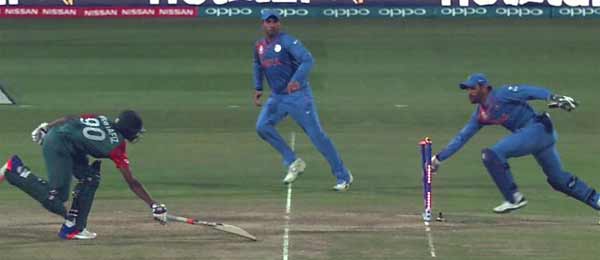
Bangalore, India (BBN)-In the third over of Bangladesh's chase, Hardik Pandya climbs high into the night, at long-on, and snatches the ball flying overhead.
In the next few seconds, as the Chinnaswamy Stadium erupts around him, Pandya appears to undergo a series of eruptions himself, reports the ESPNcricinfo.
His fists are clenched, his lungs are emptied, his vocal chords are in a state of almighty tremor.
He advances towards his teammates in violent jerks and pulses.
He is riding an invisible rodeo bull.
It had been an outstanding catch in a tough situation, so maybe exuberance is understandable.
On many nights, this may even have been the catch of the evening.
Not on this one.
In India's innings, Sabbir Rahman had tracked a ball that would have challenged any Bangalore skyscraper for height, then dived, and held the ball cleanly.
When he rose, there was a grimace on his face and slight arrogance in his gait, but there was no wild gesticulating.
Ten overs later, Soumya Sarkar tore to his left from deep square leg, dived full-length, 12 inches from the ground, and took in both hands one of the catches of the tournament.
He lay there on the grass and grinned.
His teammates paused, processed what had happened, then rushed towards him, all grinning as well.
These were moments lived out in the sudden silence that had filled the stadium.
It only made them sweeter.
This is not how all Bangladesh teams reacted to extraordinary catches.
In years past, put-on chest-thumping, aggressive flailing, and preening celebrations had sometimes defined them.
Shuvagata Hom didn't so much as bellow when he uprooted the middle stump of the best limited-overs batsman around.
There were no contrived oohs and pained looks when Mustafizur Rahman beat the bat.
Tamim Iqbal still retains a little of his old prima donna avatar, acting like he had taken a cruise missile to the chest when he had only lightly bumped Ashish Nehra.
But even he has become a more muted and more effective version of himself.
For 237 balls, Bangladesh were defined by a deep and powerful, but restrained brand of confidence.
Coach Chandika Hathurusingha has been among those leading this team to this new way - to this light.
He is not, though, the key man in the enlightenment.
With some quicks, there is almost as much pleasure to be had in their approach to the crease as their actual deliveries. Trent Boult is one of these.
Mashrafe Mortaza is not.
His thighs seem a burden to him, he makes strides of varying lengths, and occasionally appears as if he wants to pull up.
Mashrafe gets cortisone injections every year to dull the aches in his knees.
Every movement seems an effort.
At times it seems like the man's disobedient body is being dragged by the collar to the crease by his willpower.
When he bowled just one over against Australia, some wondered what he was even doing in the team.
But to understand Mashrafe, to cut to what he really means to Bangladesh, one must look some distance beyond the light spells, his damaged joints, and even his sometimes odd field placements.
To know Mashrafe the captain, we must listen to the teammates who have made Mashrafe's room their permanent haunt for joking, talking and fooling around when there is nothing else to do.
We must take note of those who have publicly spoken of the strength Mashrafe's words have bestowed them in lean times, both cricketing and personal.
We must take stock of the small seam-bowling revolution that has begun to take grip in a nation traditionally known for spin.
And so, we must conclude, that Mashrafe would be worth his place in the side, even if a fielder had to carry him to the bowling crease in a wheelbarrow.
For 237 balls, Mashrafe's team did justice to their captain's grace.
They abided by his vision.
They did right by the man, whom three days ago had been so personally affected by the suspension of Taskin Ahmed that he had got choked up and, in private, asked a journalist: "What kind of captain would I be if I can't stand beside the boy who will serve my country for the next 10-15 years?"
Bangladesh made mistakes in their chase.
Some batsmen were fortunate to have catches dropped off them.
One was unlucky to be stumped in the fraction of a second his back foot was in the air.
The men in form had made runs, and those out of touch made the best of their situation, but all were in the grip of that grim, recently-acquired determination.
And it seems fitting when Pandya is the man called upon to bowl the final over.
He is virtually mobbed by supportive team-mates when he gets the ball in hand.
There are whispers in his ear from Virat Kohli.
Dhoni deals out instructions. Ashish Nehra gives advice. Through the course of his walk from long-on to the top of his bowling mark at the opposite end of the ground, Pandya has more arms around him than a 21st-century warlord.
This is all for very little, because in truth, he bowls a poor over. Mushfiqur Rahim is sublimely calm as he drills the second ball through cover.
He showcases the wit that made him a former captain when he paddles the next ball past the wicketkeeper for a boundary.
Two runs needed from three balls.
Bangladesh have the tournament favourites and their baying home fans by the throat.
The World T20's biggest upset is at the tips of their fingers.
But this is the end of their 237 balls of glory.
In the seconds after that shot is hit, something profound is lost. Mushfiqur gets in Pandya's face.
He flails, he screams, he snarls, he pumps his arms.
In three balls, Bangladesh lose sight of the distance they have come.
They forget the captain that has inspired them.
In three balls, Bangladesh turn out the light.
BBN/SK/AD